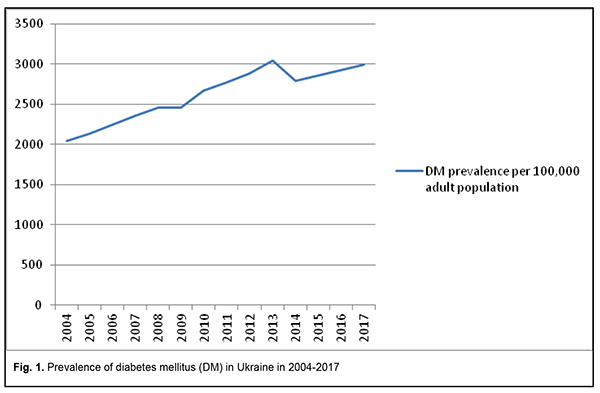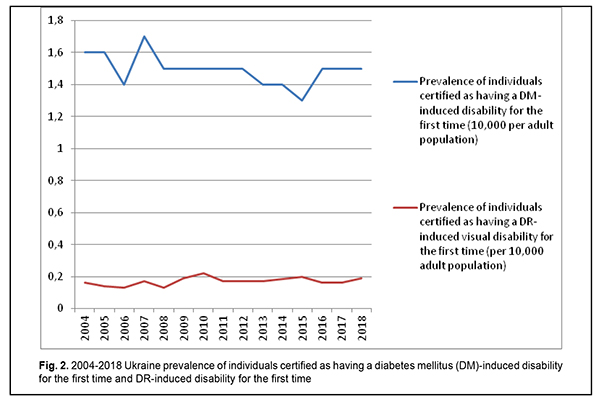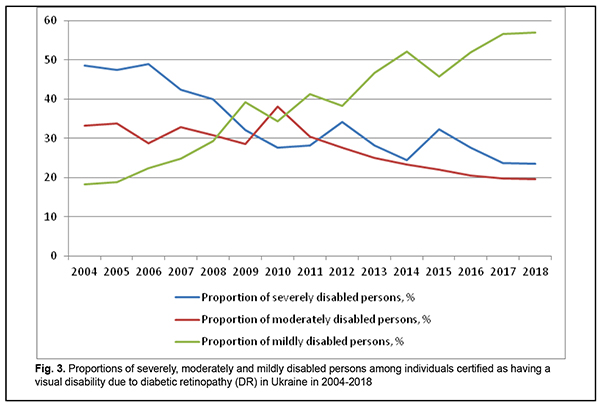J.ophthalmol.(Ukraine).2019;6:34-38.
|
http://doi.org/10.31288/oftalmolzh201963438 Received: 27 November 2019; Published on-line: 06 January 2020 Disability due to ocular complications of diabetes mellitus in Ukraine I.S. Alifanov,1 Teaching Assistant; V.N. Sakovych,1 Dr Sc (Med), Prof; T.O. Alifanova,2 Cand Sc (Med), Senior Research Fellow 1 Dnipropetrovsk Medical Academy, Ministry of Health of Ukraine; Dnipro (Ukraine) 2 Ukrainian State Research Institute for Medical and Social Problems of Disability of Ministry of Health of Ukraine; Dnipro (Ukraine) E-mail: alifanov00@gmail.com TO CITE THIS ARTICLE: Alifanov IS, Sakovych VN, Alifanova TO. Disability due to ocular complications of diabetes mellitus in Ukraine. J.ophthalmol.(Ukraine).2019;6:34-38. http://doi.org/10.31288/oftalmolzh201963438
Background: Diabetes mellitus (DM) is a global epidemic. According to reports from the WHO, DM patients have a significantly shorter life span compared to general population, and DM is among the three diseases with the highest risk of disability and mortality. Purpose: To investigate the rates of disability due to ocular complications of DM in Ukraine for the time period from 2004 to 2018. Results: The prevalence of DM in Ukraine was increasing during this period. The annual prevalence of individuals certified as having a DM-induced disability for the first time was relatively stable during 2004 through 2018 and was 1.5 per 10,000 of adult population in 2018. The annual prevalence of individuals certified as having a diabetic retinopathy (DR)-induced visual disability for the first time per 10,000 of adult population was 0.19 in 2018, and varied substantially during the period from 2004 to 2018, with a minimum of 0.13 in 2006 and 2015, maximal values of 0.22 and 0.20 in 2010 and 2015, respectively, and a general tendency to increase. During the period, changes in the prevalence of DR-induced disability varied among Ukrainian regions differing in geographical aspects. The proportion of blind and visually impaired (i.e., severely and moderately disabled, respectively) among individuals certified as having a DR-induced visual disability was higher than that among total individuals certified as having a visual disability for the first time; this indicates that the pathology is severe. The level of accumulated disability due to ophthalmic diabetes in Ukraine increased almost 2.5-fold during the last 15 years. Keywords: diabetes mellitus, diabetic retinopathy, blindness, disability
Introduction Diabetes mellitus (DM) is a global epidemic with significant morbidity and mortality. According to reports from the WHO, patients with DM have a mortality ranging from 2- to 3-fold higher, and a significantly shorter life span compared to general population. In addition, DM is among the three diseases with the highest risk of disability and mortality. An estimated 425 million adults had diabetes worldwide in 2017. This number increases annually by 5% to 7%, doubles every 12 to 15 years, and is predicted to rise to 642 million (about 10% of the world’s population) by 2040. The Ministry of Health of Ukraine estimates that, at this time, there are about 1.3 million of DM patients in the country, and according to the International Diabetes Federation Atlas, the number of people living with DM in Ukraine exceeds 2.8 million [1, 2, 3]. The current medical armamentarium against DM is sufficient to enable an active life style for patients and to extend their life. However, the main cause of disability and mortality in patients with DM is not the disease itself but its complications, which represent a generalized vascular injury resulting in persistent metabolic defects and thus leading to neuropathy, nephropathy, and retinopathy [4, 5, 6]. Diabetic retinopathy (DR) is a common microvascular complication of DM and a leading cause of blindness for adults aged 20-74 in industrialized countries. It is found in 35.4%, and proliferative disease, in 7.5% of patients with DM. Annually, approximately 700 thousand patients with DM over the world lose their vision. The proportion of global blindness caused by diabetic retinopathy was 2.6% in 2010 [7]. Compared to healthy individuals, patients with DM have a 25-fold higher risk of blindness. In addition, approximately 10% of patients with DM have visual disability. Proliferative DR is the severest form of diabetic eye disease leading to visual disability and develops in 3.5% of DM patients who have diabetes for less than 10 years, 20-30% of those who have diabetes for 10 to 15 years, and 60% who have diabetes for 20 to 30 years [8]. Patients with apparent DR have low quality of life and low scores of physical, emotional and social well being. According to the Diabetic Retinopathy Barometer Report, 79% of respondents said their vision impairment due to DR or DME made everyday activities difficult, such as driving, working and cooking or cleaning their home, and in some cases impossible, and 20% of respondents said their vision impairment due to DR or DME made it difficult to manage their diabetes [9]. Given that rates of diabetes and its disability-related complications (including those leading to visual impairment or blindness) are increasing rapidly worldwide, making a current analysis of the epidemiological situation regarding DM-induced visual disability in Ukraine is deemed important. The purpose of the study was to investigate the rates of disability due to ocular complications of diabetes mellitus in Ukraine for the time period from 2004 to 2018. Specifically, we aimed to analyze data on the prevalence and severity of DR-induced visual disability, the proportion of the overall visual disability attributable to DR, and changes in these characteristics over time. Material and Methods The following information sources were used to investigate the epidemiological data: statistical reports issued by relevant Medico-Social Expert Commissions (MSECs) based on assessment and examination of patients with eye problems in Kyiv City and Kyiv Region (2004-2018), annual analytical and information booklet named “Major Indicators of Disability and Activities of MSECs (2004-2018)”, and diabetes prevalence reports for 2004 to 2017 issued by the Medical Statistics Center of the Ministry of Health of Ukraine. The previous study on this subject was conducted 15 years before, in 2004 [10]. Results and Discussion It is reasonable to investigate interrelated indices of the prevalence of DM, disability resulting from DM, and visual disability due to any cause. The prevalence of diabetes mellitus in Ukraine increased from 2,043.1 per 100,000 population in 2004 to 2,996 per 100,000 population in 2017, which reflects worldwide trends. There were 1,270,929 nationally registered individuals with diabetes mellitus in 2017, compared to 969,269 in 2004. It is noteworthy that the number of registered diabetics increased by 31%, although the registered population decreased, partially at the expense of the Autonomous Republic of Crimea and occupied territories of Donetsk and Lugansk regions (Fig. 1).
In Ukraine, diabetes mellitus was found to account for 3.3% of all adult individuals certified as disabled for the first time, and for 3.1% of all working-age individuals certified as disabled for the first time. Although in this country, diabetes mellitus is only the 11th most common cause of disability among all individuals certified as disabled for the first time, it is one of the most common causes of severe disability and mortality. In 2018, the total number of individuals certified as having a DM-induced disability for the first time was 4,554, which corresponded to an annual prevalence of 1.5 per 10,000 of adult population, and 1.6 per 10,000 of working-age population. The value of this index varied insubstantially during the period from 2004 to 2018, with a maximum of 1.7 per 10,000 of adult population in 2007, and a minimum of 1.3 per 10,000 of adult population in 2013, and a tendency to a gradual increase in subsequent years. In 2018, annual prevalence of individuals certified as having a DM-induced disability for the first time in the regions of Lviv (2.0 per 10,000 of adult population), Odesa (1.9), Kyiv (1.8), Kirovograd (1.8), Vinnytsia (1.7), and Chernivtsi (1.7) were higher than the mean national rate. The lowest rates were noted in the regions of Khmelnytskyi (0.9 per 10,000 of adult population), Volyn (1.0), Zhytomyr (1.1), Lugansk (1.1), and Poltava (1.1), probably, due to lower prevalence of diabetes mellitus in populations of these regions. There was a tendency towards an increase in the proportion of overall individuals certified as having a visual disability for the first time due to DR. In 2018 in Ukraine, 12% (548 individuals) of the total number of individuals certified as having a DM-induced disability for the first time were having a DR-induced visual disability, with an annual prevalence of individuals certified as having a DR-induced visual disability for the first time of 0.19 per 10,000 of adult population. Of these, 23.54%, 19.52% and 56.93% were certified as severely (category 1), moderately (category 2), and mildly (category 3) disabled. Annual prevalence of individuals certified as having a DR-induced visual disability for the first time varied substantially during the period from 2004 to 2018 (Fig. 2), with a minimum of 0.13 per 10,000 of adult population in 2006 and 2015, maximal values of 0.22 and 0.20 per 10,000 of adult population in 2010 and 2015, respectively, and an increase from 0.16 to 0.19 per 10,000 of adult population in the three last years of this period.
Of note is the difference in magnitude and direction of changes between the rates of DR-induced visual disability and DM-induced disability during the period of 2004 to 2018, although there was a tendency towards increases in both indices in the last years of this period. In 2018, prevalence of individuals certified as having a DR-induced visual disability for the first time in the regions of Volyn (0.92 per 10,000 of adult population), Zakarpattia (0.9), Zhytomyr (0.65), Rivne (0.34), and Kharkiv (1.7) were higher than the mean national level, and in the regions of Lviv (0.04 per 10,000 of adult population), Kherson (0.05), Chernigiv (0.05), Cherkasy (0.07), Khmelnytskyi (0.07), Dnipropetrovsk (0.08), Odesa (0.08) and the city of Kyiv (0.06), were lower than the mean national level. During the period from 2004 to 2018, changes in the prevalence of DR-induced disability varied among Ukrainian regions differing in geographical and socioeconomic aspects, diabetic and eye care organization level, and medical and social expertise level, and the value of this index decreased in the regions of Dnipropetrovsk, Odesa, Lviv and the city of Kyiv, and increased in the regions of Volyn, Zhytomyr, Zakarpattia and Kharkiv. The prevalence of individuals certified as having a visual disability in Ukraine is 1.78 per 10,000 of adult population, and, in 2018, 5,662 individuals were certified as visually disabled for the first time. Of these, 15%, 14% and 71% were certified as severely (category 1), moderately (category 2), and mildly (category 3) disabled. The data above indicate that the proportion of blind and visually impaired (i.e., severely and moderately disabled, respectively) among individuals certified as having a DR-induced visual disability was higher than that among total individuals certified as having a visual disability for the first time; this indicates that the pathology is severe. In 2018 in Ukraine, glaucoma was found to be the most common cause of visual disability (18.9%), followed by fundus disorders (18.7%) and ocular trauma sequelae (16.1%), and the list of most common national causes of visual disability was different from the list of the most common global causes. It is noteworthy that DR accounted for about half (51.8%) of individuals certified as having a visual disability due to fundus disorders, and for about a tenth (10.7%) of total individuals certified as having a visual disability for the first time. Of note is a reduction in severity of DR-induced disability during the period of observation, with reductions in the proportions of severely and moderately disabled individuals from 48.58% and 33.2%, respectively, in 2004, to 23.54% and 19.5%, respectively, in 2018, and an increase in the proportion of mildly disabled individuals from 18.22% in 2004 to 56.93% in 2018 (Fig. 3).
Interestingly, that, compared with the number of individuals certified as having a DR-induced visual disability for the first time, the number of individuals re-certified as having a DR-induced visual disability was 1.5-fold higher in 2004 (747 vs 494), and 3.5-fold higher in 2018 (1841 vs 548), which reflects an increased level of accumulated disability. This gives rise to concerns, because in 25-30% of cases, a person re-certified as having a visual disability due to ophthalmic diabetes is given a disability status “for life”, and, as a result, loses contact with MSEC, which affects the quality and efficacy of medico-social rehabilitation of individuals certified as having a visual disability due to ophthalmic diabetes. Conclusion First, the prevalence of diabetes mellitus in Ukraine was increasing during the period from 2004 to 2018 (and was as high as 2,996 per 100,000 population in 2017), which reflects worldwide trends. Second, the annual prevalence of individuals certified as having a DM-induced disability for the first time was relatively stable with a slight tendency toward a decrease, and was 1.5 per 10,000 of adult population in 2018. It, however, increased from 1.3 per 10,000 of adult population to 1.5 per 10,000 of adult population in the three last years of this period. Third, the annual prevalence of individuals certified as having a DR-induced visual disability for the first time was 0.19 per 10,000 of adult population in 2018, and varied substantially during the period from 2004 to 2018, with a minimum of 0.13 per 10,000 of adult population in 2006 and 2015, maximal values of 0.22 and 0.20 per 10,000 of adult population in 2010 and 2015, respectively, and a general tendency to increase. Fourth, during the period from 2004 to 2018, changes in the prevalence of DR-induced disability varied among Ukrainian regions differing in geographical and socioeconomic aspects, diabetic and eye care organization level, and medical and social expertise level. Fifth, of note is that the proportion of blind and visually impaired (i.e., severely and moderately disabled, respectively) among individuals certified as having a DR-induced visual disability was higher than that among total individuals certified as having a visual disability for the first time; this indicates that the pathology is severe. Finally, the level of accumulated disability due to ophthalmic diabetes in Ukraine increased almost 2.5-fold during the last 15 years.
References 1.International Diabetes Federation. IDF Diabetes Atlas. 8th Ed. Brussels: International Diabetes Federation; 2017. Available at: http://www.diabetesatlas.org. 2.International Council Of Ophthalmology. ICO Guidelines for Diabetic Eye Care (2017). Available at: http://www.icoph.org/downloads/ICOGuidelinesforDiabeticEyeCare.pdf 3.Zborovska OV, Pilkevich TS, Kuryltsiv NB, Samoluk NA. Proliferative diabetic retinopathy in unsuspected diabetes mellitus: a case report. J.ophthalmol. (Ukraine). 2019;2:67-9. 4.Emerging Risk Factors Collaboration, Sarwar N, Gao P, Sechasai SR, Golin R, Kaptoge S, et al. Diabetes mellitus, fasting blood glucose concentration, and risk of vascular disease: a collaborative meta-analysis of 102 prospective studies. Lancet. 2010 Jun 26;375(9733):2215-22. 5.Pasyechnikova NV, Naumenko VA, Vit VV, Ivanitskaya EV, Pilkevich TS. [Structural changes of the retina, erythropoietin concentration in the vitreous body and peripheral blood in streptozotocin-induced diabetic rats in experiment (intermediate result)]. J Ophthalmol (Ukraine). 2014;3:69-75. Ukrainian. 6.Sakovich VN, Ahmad Abed Al Raheem Abdallah Aqrabawi. [The influence of nicotinamide and preparations containing it on the level of oxidated and reduced forms of nicotinamide coenzymes in the retina of rats with streptosotocine diabetes]. J Ophthalmol (Ukraine). 2013;1:57-61. Ukrainian. 7.Bourne RR, Stevens GA, White RA, Smith JL, et al. Causes of vision loss worldwide, 1990-2010: a systematic analysis. Lancet Glob Health. 2013 Dec;1(6):e339-49. 8.Bezditko PA, Gorbachova EV. [Epidemiology and prevalence of diabetes mellitus and diabetic retinopathy]. International journal of endocrinology. 2006;4(6). Russian. Available at: http://www.mif-ua.com/archive/article/2062. 9.Cavan D, Makaroff L, da Rocha Fernandes J, Sylvanowicz M, et al. The Diabetic Retinopathy Barometer Study: Global perspectives on access to and experiences of diabetic retinopathy screening and treatment. Diabetes Res Clin Pract. 2017 Jul;129:16-24. 10.Rykov SO, Alifanova TO, Alifanov IS. [Disability due to ocular complications of diabetes mellitus in Ukraine]. J Ophthalmol (Ukraine). 2006;3:126-8. Ukrainian.
The authors certify that they have no conflicts of interest in the subject matter or materials discussed in this manuscript.
|



